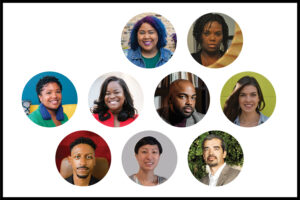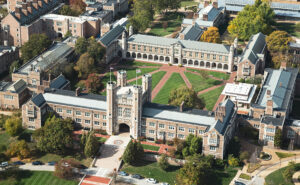The Indian Institute of Management Ahmedabad (IIMA), a premier global management Institute, today announced two key initiatives in line with its future growth plans. The institute shared two decisions taken by the IIMA Board of Governors- the launch of a redesigned website along with a refreshed logo and a go-ahead on the reconstruction of some parts of the old campus, which is guided by the twin objective of ensuring the safety of residents on campus and facilitate the expansion of the campus infrastructure as part of the institute’s growth goals.
Professor Errol D’Souza, Director at IIMA, shared details pertaining to these decisions on behalf of the Board. Also present on the occasion were Prof. Ajay Pandey, member, IIMA Board of Governors and Professor Hyokjin Kwak, IIMA Chair Professor and Professor of Marketing and head of the Website Task Force.
“As IIMA and its ethos shapes and adapts to global shifts, the institute felt the need to re-envision the IIMA website and renew its visual identity, which is represented by its logo. The new website embodies the IIMA brand philosophy of ‘Simple, Bold, and Global.’ After consulting with and incorporating feedback from relevant stakeholders, the logo refresh was also completed. The refreshed logo aims to convey a more vivid and vibrant brand identity while retaining all the elements of the existing IIMA logo that evoke and channel trust, authenticity, and legacy by emphasising a strong connection to Indian culture.”- IIMA Board of Governors.
The new website will reflect IIMA’s position as a preeminent institution of management across the world. The idea was to make the website more engaging with prospective students, alumni, current students & faculty and reflect the institute’s voice as a global leader in research, teaching, innovation while maintaining the bold & global image of the institute.
Highlights of the redesigned IIMA website.
· A clean and bold user interface that highlights the most important aspects of the institute
· Responsive Fluid Design for all browsers
· Intuitive User Experience (UX) like large news & publication portals
· Global design language and responsiveness to smart devices.
· Built on a robust & scalable platform to make it future ready
· Simplified navigation & uniquely build menu navigation for seamless user journey across desktop, tablets & mobile devices.
· User portals for paperless interaction between faculty & administration
· E-commerce capability with Executive Education, Case Centre & IIMA e-store
For a digital-first world, the refreshed logo has ‘IIMA’ as a single wordmark which is a recognition of the unique identity of the Indian Institute of Ahmedabad as an institute of national importance that is built on the association with this city since its inception. The Sanskrit inscription Vidya Viniyogadvikasa (development through the distribution or application of knowledge) continues to be an integral part of the logo. The logo also has refreshed the ‘jali’ work with clear and bold lines and curves in navy blue, which, while retaining the original aesthetics of the logo art, makes it digitally discernible on any device and adaptable to all formats. The ‘jali’ in the logo of the institute symbolizes the roots of the Institute in the western Indian city of Ahmedabad.
The second decision of the IIMA Board pertains to the reconstruction of some buildings in the old campus, The Institute takes pride of its antecedents and the rich legacy including the iconic architecture, which were all pivotal in its growth into a premier world-class institution. However, over time, some of the buildings have been facing structural damage, deterioration and have become uninhabitable, posing a safety concern for the campus’s residents. The discussions and consultations on this matter, inclusive of nationally and globally recognized expert-led reports, have been on for almost 40 years and extensively since the last two decades. The deterioration of the structures was raised first at a Building Committee meeting in July 1982. Most importantly, the Board considered all relevant reports, especially the ones that were undertaken in the last year. This included meetings and presentations by two groups of experts who were tasked with the assessment of the conditions and structural status of the buildings and who visited campus to conduct a study first-hand. The first was a group of structural and earthquake engineers from IIT Roorkee and the second, an international group comprising restoration experts, architects, and structural engineers. The board finalised the decision after it had initiated the process of consultations that it had been holding with key stakeholders (alumni and faculty) prior to December 2020. In line with the decision, The Institute will not continue with any further restoration of the faculty blocks, classroom complex, and dorms other than D15. After careful consideration, an RFP process will be initiated later for the reconstruction of the faculty blocks, classroom complex, and the peripheral dorms 16 to 18 with, the same exterior façade, a seismically safe structure, and non-major renovation of the internal space to improve its functionality to suit the needs of the users. The other dorms will be remodeled, in line with the Louis Kahn heritage and keeping in mind the functional needs of current and future residents of the campus.
“Over the last two decades, the institute has conducted regular inspections, studies, and repairs on the buildings. Repairs were made whenever subject matter experts recommended it or there was any visible indication of a problem. The safety of our people is our primary responsibility, and with that in mind, the Board felt there was a need to address this issue rather than opt for temporary solutions such as restorations, which had been attempted but were not as effective. The Board consulted industry experts and discussed the issue for several months before making this decision regarding the reconstruction of parts of the old campus. All reports indicate that most structural elements have insignificant residual life, and thus restoration will be technically impractical and ineffective despite investment of time, effort, and funds. As a result, rebuilding in such sections of the old campus is unavoidable. We express our deep gratitude for the wisdom and advice provided by our various stakeholders and experts throughout the process.”- IIMA Board of Governors.


